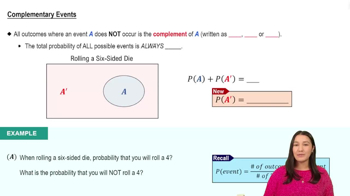Table of contents
- 1. Introduction to Statistics53m
- 2. Describing Data with Tables and Graphs2h 1m
- 3. Describing Data Numerically1h 48m
- 4. Probability2h 26m
- 5. Binomial Distribution & Discrete Random Variables2h 55m
- 6. Normal Distribution & Continuous Random Variables1h 48m
- 7. Sampling Distributions & Confidence Intervals: Mean1h 17m
- 8. Sampling Distributions & Confidence Intervals: Proportion1h 20m
- 9. Hypothesis Testing for One Sample1h 8m
- 10. Hypothesis Testing for Two Samples2h 8m
- 11. Correlation48m
- 12. Regression1h 4m
- 13. Chi-Square Tests & Goodness of Fit1h 30m
- 14. ANOVA1h 4m
4. Probability
Complements
Struggling with Statistics for Business?
Join thousands of students who trust us to help them ace their exams!Watch the first videoMultiple Choice
A weatherman states that the probability that it will rain tomorrow is 10%, or 0.1, & the probability that it will snow is 25%, or 0.25. What is the probability that it will not rain or snow?
A
0.35
B
0.65
C
0.75
D
0.90
 Verified step by step guidance
Verified step by step guidance1
Identify the given probabilities: the probability of rain (P(Rain)) is 0.1 and the probability of snow (P(Snow)) is 0.25.
Understand that the problem asks for the probability that it will not rain or snow. This is the complement of the event that it will either rain or snow.
Calculate the probability of rain or snow using the formula for the union of two events: P(Rain or Snow) = P(Rain) + P(Snow) - P(Rain and Snow).
Assume that rain and snow are independent events, meaning P(Rain and Snow) = P(Rain) * P(Snow). Calculate this value.
Find the probability that it will not rain or snow by taking the complement of the probability of rain or snow: P(Not Rain or Snow) = 1 - P(Rain or Snow).

 4:23m
4:23mWatch next
Master Complementary Events with a bite sized video explanation from Patrick
Start learningRelated Videos
Related Practice

